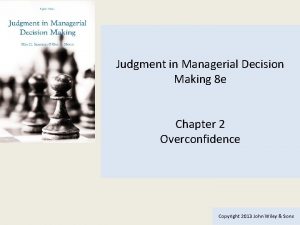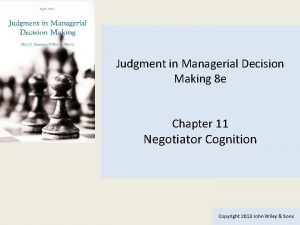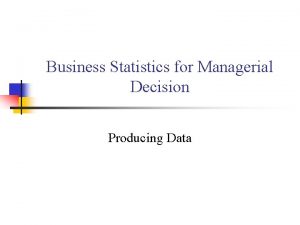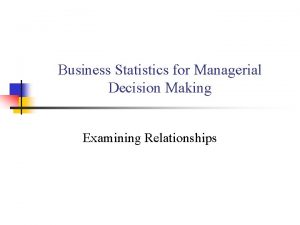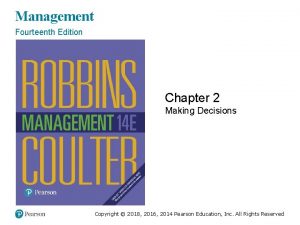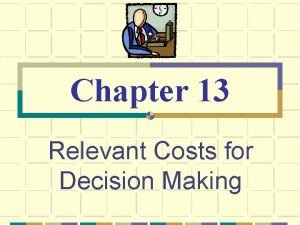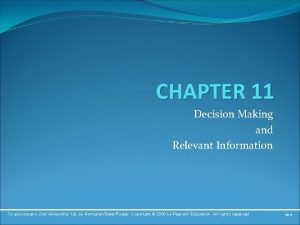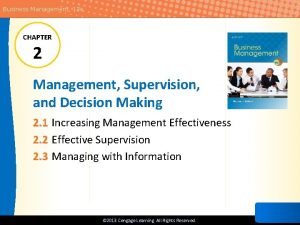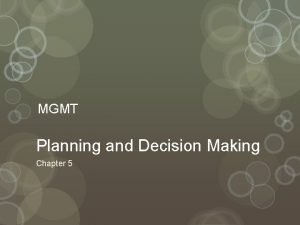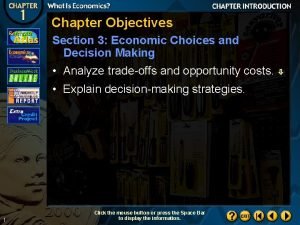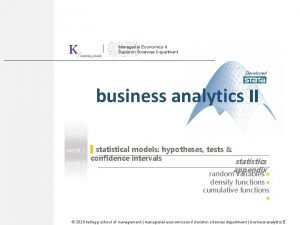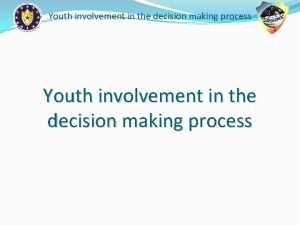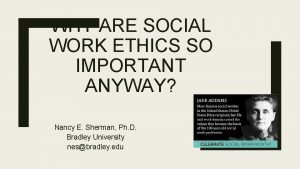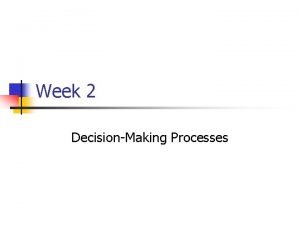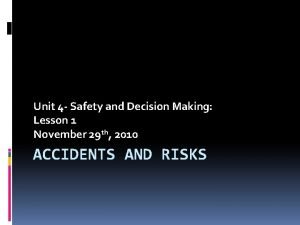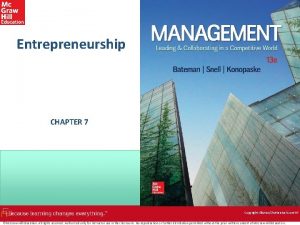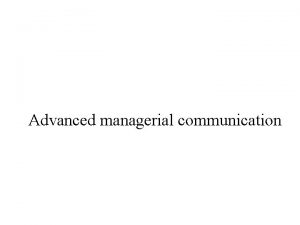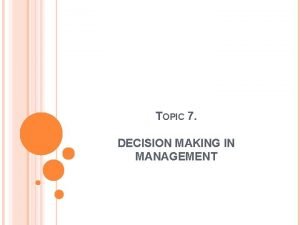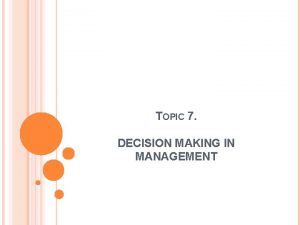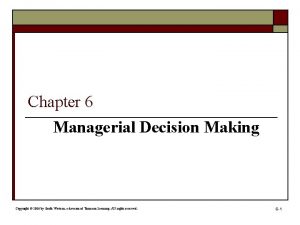Managerial Decision Making CHAPTER 3 Copyright zlikovecShutterstock com

































- Slides: 33

Managerial Decision Making CHAPTER 3 Copyright zlikovec/Shutterstock. com RF ©Mc. Graw‐Hill Education. All rights reserved. Authorized only for instructor use in the classroom. No reproduction or further distribution permitted without the prior written consent of Mc. Graw‐Hill Education.

Chapter Introduction Quote “The business executive is by profession a decision maker. Uncertainty is his opponent. Overcoming it is his mission. ” John Mc. Donald ©Mc. Graw‐Hill Education.

Learning Objectives 1 2 3 4 5 Describe the kinds of decisions you will face as a manager. Summarize the steps in making “rational” decisions. Recognize the pitfalls you should avoid when making decisions. Evaluate the pros and cons of using a group to make decisions. Identify procedures to use in leading a decision‐making group. 6 Explain how to encourage creative decisions. 7 Discuss the process by which decisions are made in organizations. 8 Describe how to make decisions in a crisis. ©Mc. Graw‐Hill Education.

Characteristics of Managerial Decisions Risk ©Mc. Graw‐Hill Education. Uncertainty Lack of structure Conflict

Lack of Structure Programmed decisions Decisions encountered and made before, having objectively correct answers, and solvable by using simple rules, policies, or numerical computations Nonprogrammed decisions New, novel, complex decisions having no proven answers ©Mc. Graw‐Hill Education.

Examples of Decisions by Type Programmed Nonprogrammed Business Firm • Telephone scripts for employees to follow • Diversification into new products and markets University • Necessary GPA for good academic standing • Raising funds to build new student Healthcare • Procedure for admitting patients • Purchase of experimental equipment ©Mc. Graw‐Hill Education. SOURCE: Adapted from Gibson, J. , Ivancevich, J. , Donnelly Jr. , J. and Konopaske, R. , Organizations: Behavior, Structure, Processes, 14 th ed. New York: Mc. Graw‐Hill, 2011.

Uncertainty and Risk Certainty The state that exists when decision makers have accurate and comprehensive information Uncertainty The state that exists when decision makers have insufficient information Risk The state that exists when the probability of success is less than 100 percent and losses may occur ©Mc. Graw‐Hill Education.

Conflict and its Levels Conflict Opposing pressures from different sources, occurring on the level of psychological conflict or of conflict between individuals or groups ©Mc. Graw‐Hill Education. Levels of Conflict 1. Individual decision makers 2. Conflict between people

The Phases of Decision Making 1. Identifying and Diagnosing the Problem 2. Generating Alternative Solutions 3. Evaluating Alternatives 4. Making the Choice 5. Implementing the Decision 6. Evaluating the Decision ©Mc. Graw‐Hill Education.

Identifying and Diagnosing the Problem Recognize there is a gap between the current and desired state. Is there an opportunity that can be exploited? Diagnose the reason for the performance gap. ©Mc. Graw‐Hill Education.

Generating Alternative Solutions Ready-made solutions Ideas that have been seen or tried before Custom-made solutions New, creative solutions designed specifically for the problem ©Mc. Graw‐Hill Education.

Evaluating Alternatives Evaluating alternatives • What is the value or adequacy of the alternatives generated? • Which solution will be the best? • How will you measure success? Contingency plans Alternative courses of action that can be implemented based on how the future unfolds. ©Mc. Graw‐Hill Education.

Making the Choice Maximizing A decision realizing the best possible outcome ©Mc. Graw‐Hill Education. Satisficing Choosing an option that is acceptable, although not necessarily the best or perfect Optimizing Achieving the best possible balance among several goals

Social Enterprise Saul Garlick’s Social Enterprise While still in high school, Saul Garlick founded a nonprofit to fight poverty in Africa by encouraging entrepreneurship. He later decided he could best do the work of his nonprofit by converting it to a for‐profit social enterprise, Think. Impact. • What are the advantages and disadvantages of market‐based solutions to problems in developing countries? • Would you consider attending a Think. Impact learning program in an international location? Why or why not? ©Mc. Graw‐Hill Education.

Implementing the Decision 1. Determine how things will look when the decision is fully operational. 2. Chronologically order the steps necessary to achieve a fully operational decision. 3. List the resources and activities required to implement each step. 4. Estimate the time needed for each step. 5. Assign responsibility for each step to specific individuals. ©Mc. Graw‐Hill Education.

Implementation Questions What problems could this action cause? What can we do to prevent the problems? What unintended benefits or opportunities could arise? How can we make sure they happen? How can we be ready to act when the opportunities come? ©Mc. Graw‐Hill Education.

Evaluating the Decision Positive feedback Negative feedback • Suggests the decision is Suggests either the working implementation will: • Implies that the decision should be continued and applied elsewhere ©Mc. Graw‐Hill Education. • Require more resources, or • Bad decision

The Best Decision Vigilance A process in which a decision maker carefully executes all stages of decision making ©Mc. Graw‐Hill Education.

Barriers to Effective Decision Making Psychological biases • Illusion of control • Framing effects • Discounting the future Time pressure Social realities ©Mc. Graw‐Hill Education. Copyright Al Seib/Los Angeles Times/Getty Images

Pros and Cons of Group Decision Making Potential Advantages • Larger pool of information • More perspectives and approaches • Intellectual stimulation • People understand the decision • People are committed to the decision ©Mc. Graw‐Hill Education. Potential Disadvantages • One person dominates • Satisficing • Groupthink • Goal displacement • Social loafing

Groupthink and Goal Displacement Groupthink Occurs when people choose not to disagree or raise objections because they don’t want to break up a positive team spirit Goal displacement A condition that occurs when a decision‐making group loses sight of its original goal and a new, less important goal emerges ©Mc. Graw‐Hill Education.

Exhibit 3. 8 Managing Group Decision Making Jump to Appendix 1 for long description of image. ©Mc. Graw‐Hill Education.

Conflict Types Cognitive conflict Issue‐based differences in perspectives or judgments Affective conflict Emotional disagreement directed toward other people ©Mc. Graw‐Hill Education. Copyright Yuri Arcurs/Alamy Stock Photo RF

Encouraging Conflict Devil’s advocate A person who has the job of criticizing ideas to ensure that their downsides are fully explored Dialectic A structured debate comparing two conflicting courses of action ©Mc. Graw‐Hill Education.

Encouraging Creativity Creation • Brining a new thing into being Synthesis • Joining previously unrelated things Modification • Improving something or giving it a new application ©Mc. Graw‐Hill Education.

Brainstorming A process in which group members generate as many ideas about a problem as they can; criticism is withheld until all ideas have been proposed. ©Mc. Graw‐Hill Education. Copyright dotshock/123 RF RF

Improving the Effectiveness of Brainstorming Use well‐thought‐out questions as a platform to spark new ideas. Choose participants based on their expertise and knowledge of the challenge. Break up large groups into subgroups of 3– 5 people. Ask subgroups to think deeply to generate 2– 3 solutions for each key question explored. Do not have the full group evaluate the winning ideas, but rather ask subgroups to identify their top 2 or 3 Ideas. Act quickly on key ideas and provide feedback to all participants. ©Mc. Graw‐Hill Education.

Models of Organizational Decision Processes (1 of 2) Bounded rationality A less‐than‐perfect form of rationality in which decision makers cannot be perfectly rational because decisions are complex and complete information is unavailable or cannot be fully processed Incremental model Model of organizational decision making in which major solutions arise through a series of smaller decisions ©Mc. Graw‐Hill Education.

Models of Organizational Decision Processes (2 of 2) Coalitional model Model of decision making in which groups with differing preferences use power and negotiation to influence decisions Garbage can model Model of organizational decision making depicting a chaotic process and seemingly random decisions ©Mc. Graw‐Hill Education.

Decision Making in a Crisis • What kinds of crises could your company face? • Can your company detect a crisis in its early stages? • How will it manage a crisis if one occurs? • How can it benefit from a crisis after it has passed? ©Mc. Graw‐Hill Education. Copyright Laura Ballard/123 RF RF

Elements of a Crisis Plan Strategic actions Technical and structural actions Evaluation and diagnostic actions Communication actions Psychological and cultural actions SOURCES: Meyers, G. with J. Holusha, When It Hits the Fan: Managing the Nine Crises of Business. Boston: Houghton Mifflin, 1986; and Bacharach, S. and Bamberger, P. , "9/11 and New York City Firefighters' Post Hoc Unit Support and Control Climates: A Context Theory of the Consequences of Involvement in Traumatic Work‐Related Events, " Academy of Management Journal, 50, 2007, pp. 849‐ 68. ©Mc. Graw‐Hill Education.

Management in Action Uber in Crisis Uber has recently experienced a series of escalating crises that could imperil its future. In addition to allegations of widespread sexism and sexual harassment, Uber recently faced accusations from current and former employees that for years it has fraudulently applied a data‐sharing program to secretly identify and evade enforcement officials. • What management decisions within Uber probably led to the Greyball crisis? • What principles of group decision making could help Uber make decisions during this crisis? ©Mc. Graw‐Hill Education.

In Review 1 2 3 4 5 Describe the kinds of decisions you will face as a manager. Summarize the steps in making “rational” decisions. Recognize the pitfalls you should avoid when making decisions. Evaluate the pros and cons of using a group to make decisions. Identify procedures to use in leading a decision‐making group. 6 Explain how to encourage creative decisions. 7 Discuss the process by which decisions are made in organizations. 8 Describe how to make decisions in a crisis. ©Mc. Graw‐Hill Education.
 Dậy thổi cơm mua thịt cá
Dậy thổi cơm mua thịt cá Cơm
Cơm Judgment in managerial decision making 8th edition
Judgment in managerial decision making 8th edition Judgment in managerial decision making
Judgment in managerial decision making Managerial versus entrepreneurial decision making
Managerial versus entrepreneurial decision making Statistics for managerial decision making
Statistics for managerial decision making Statistics for managerial decision making
Statistics for managerial decision making No decision snap decision responsible decision
No decision snap decision responsible decision Investment decision financing decision dividend decision
Investment decision financing decision dividend decision Chapter 6 prices and decision making assessment answers
Chapter 6 prices and decision making assessment answers Chapter 11 decision making and relevant information
Chapter 11 decision making and relevant information Chapter 2 economic systems and decision making answer key
Chapter 2 economic systems and decision making answer key Management chapter 5 planning and decision making
Management chapter 5 planning and decision making Financial decision-making process
Financial decision-making process Chapter 2 economic systems and decision making
Chapter 2 economic systems and decision making Copyright
Copyright Relevant cost for decision making solution chapter 13
Relevant cost for decision making solution chapter 13 Chapter 2 economic systems and decision making answer key
Chapter 2 economic systems and decision making answer key Chapter 11 decision making and relevant information
Chapter 11 decision making and relevant information Chapter 2 management supervision and decision making
Chapter 2 management supervision and decision making Relevant information for decision making
Relevant information for decision making Management chapter 5 planning and decision making
Management chapter 5 planning and decision making Chapter 1 section 3 economic choices and decision making
Chapter 1 section 3 economic choices and decision making Managerial decision problems
Managerial decision problems Managerial economics and decision sciences
Managerial economics and decision sciences Decision table and decision tree examples
Decision table and decision tree examples Youth involvement
Youth involvement Reamer ethical decision making model
Reamer ethical decision making model Systematic decision making process
Systematic decision making process Paced decision making
Paced decision making Using recursion in models and decision making
Using recursion in models and decision making Using functions in models and decision making
Using functions in models and decision making What is this image
What is this image Unit 4 lesson 1 decision making
Unit 4 lesson 1 decision making


